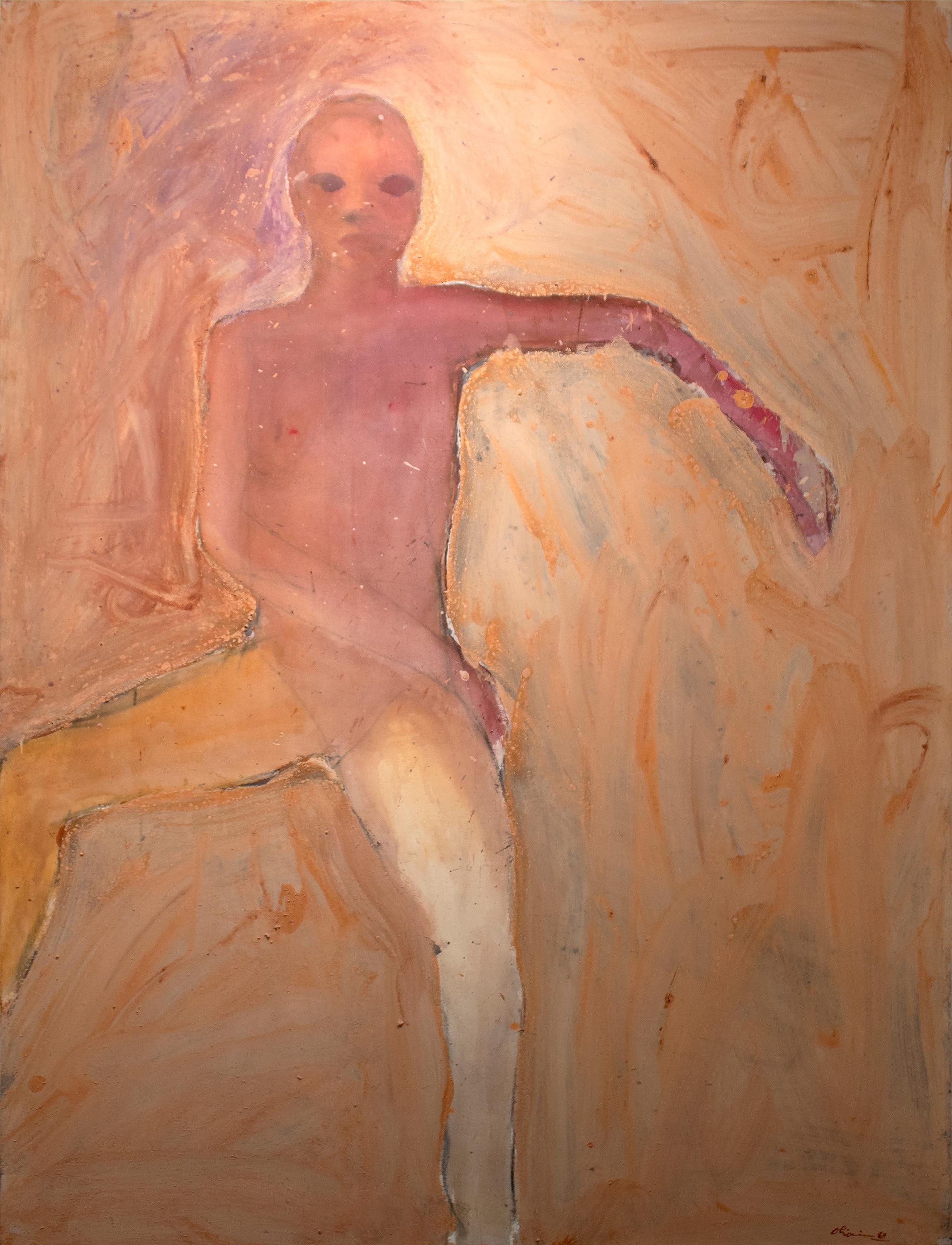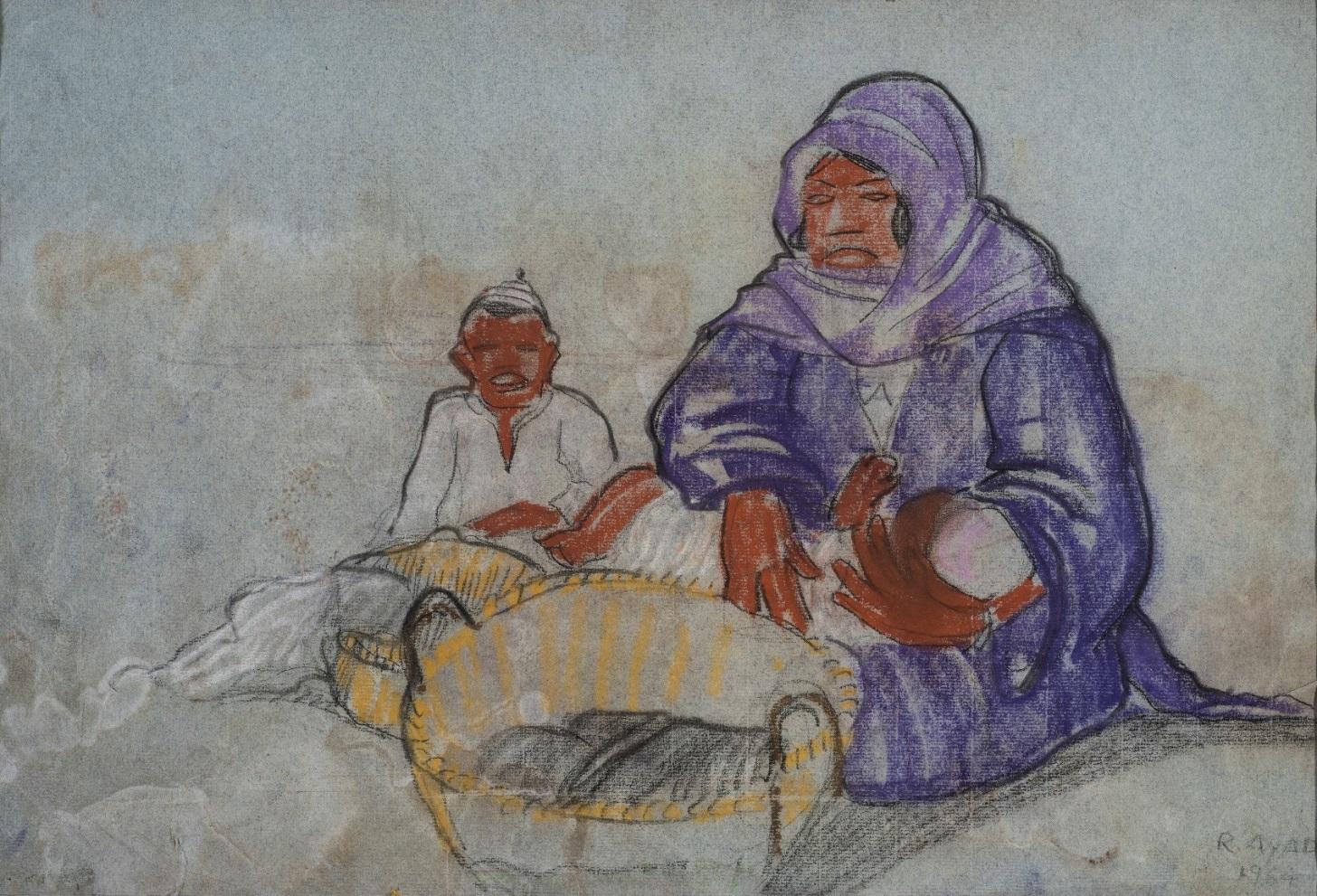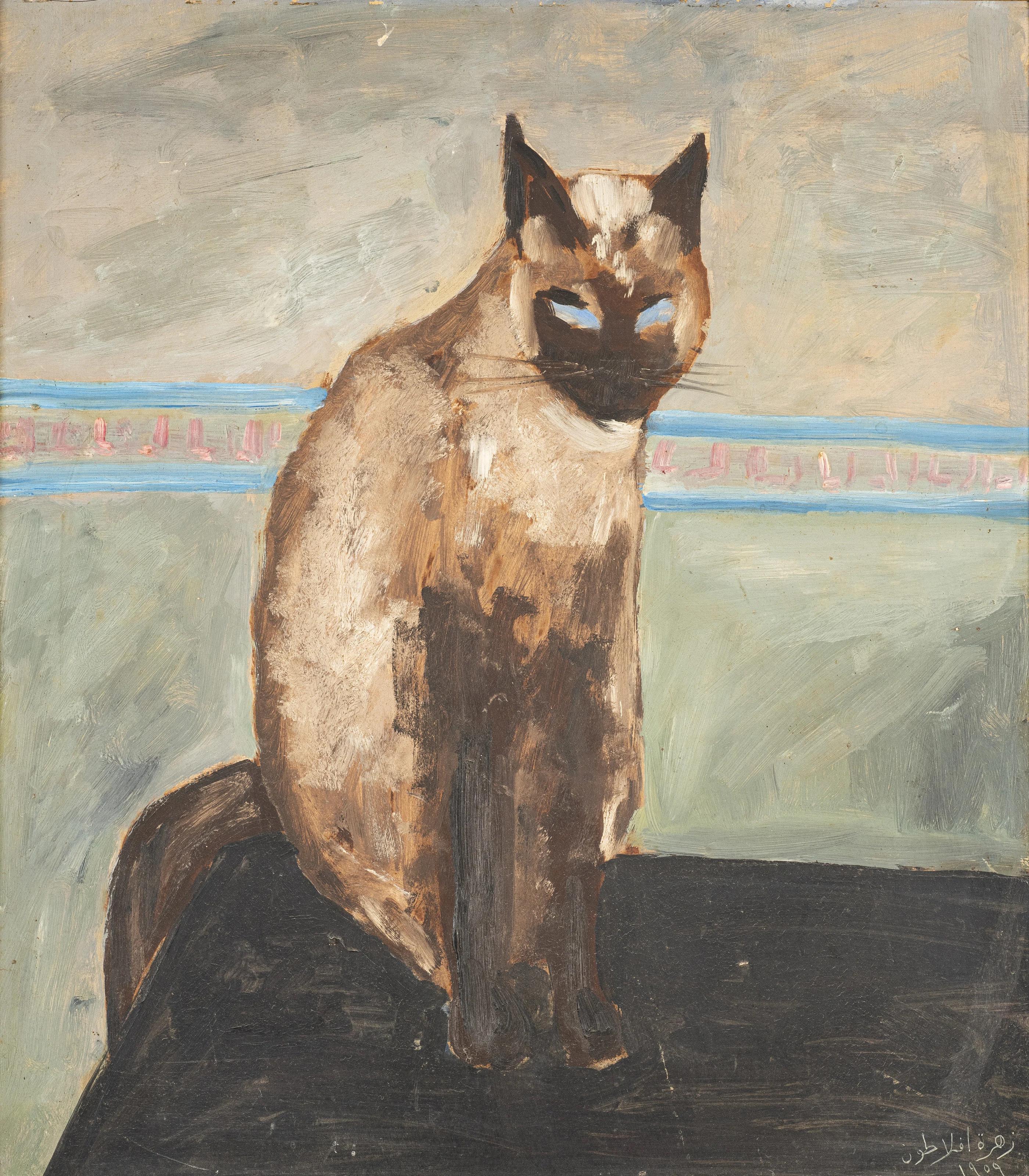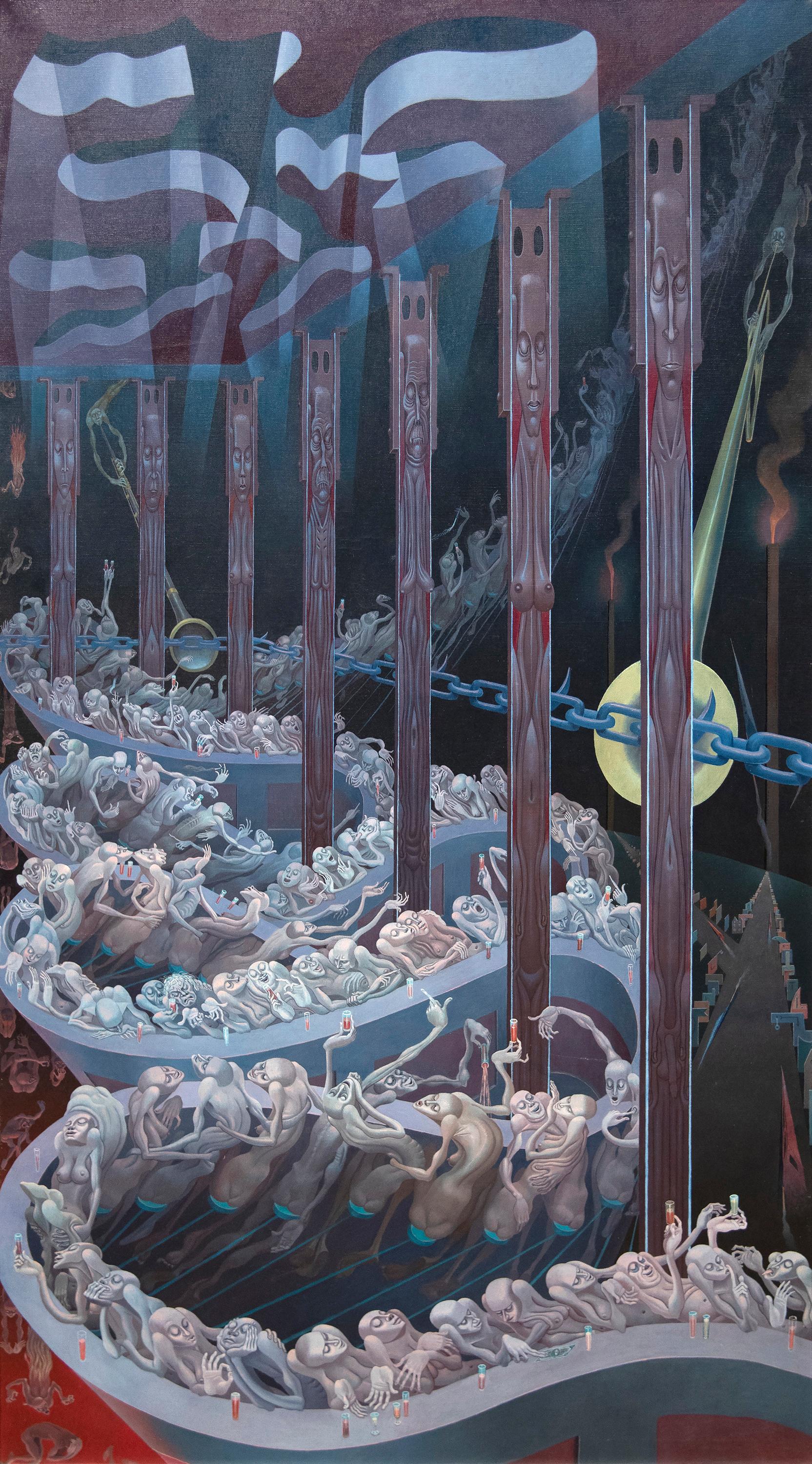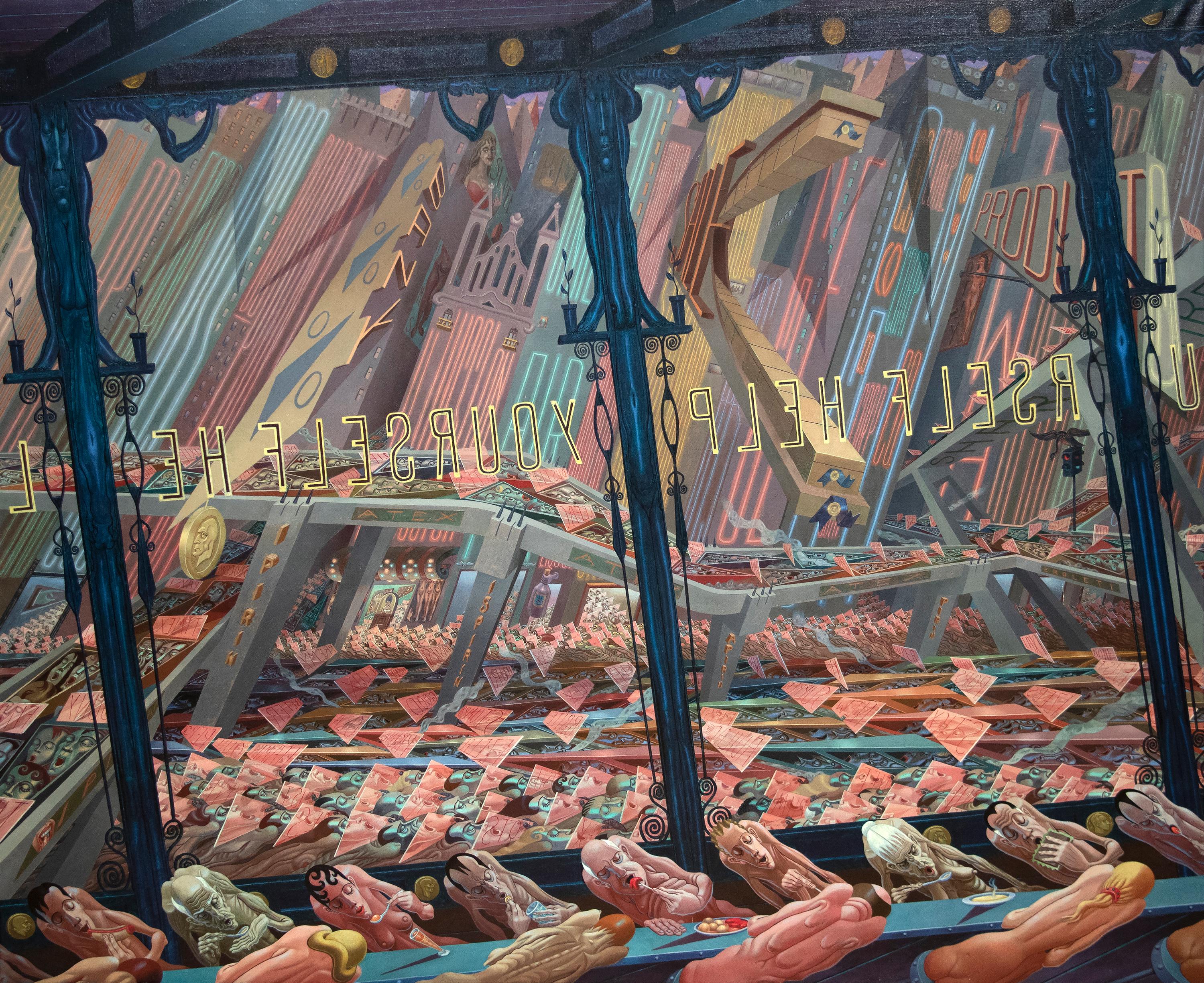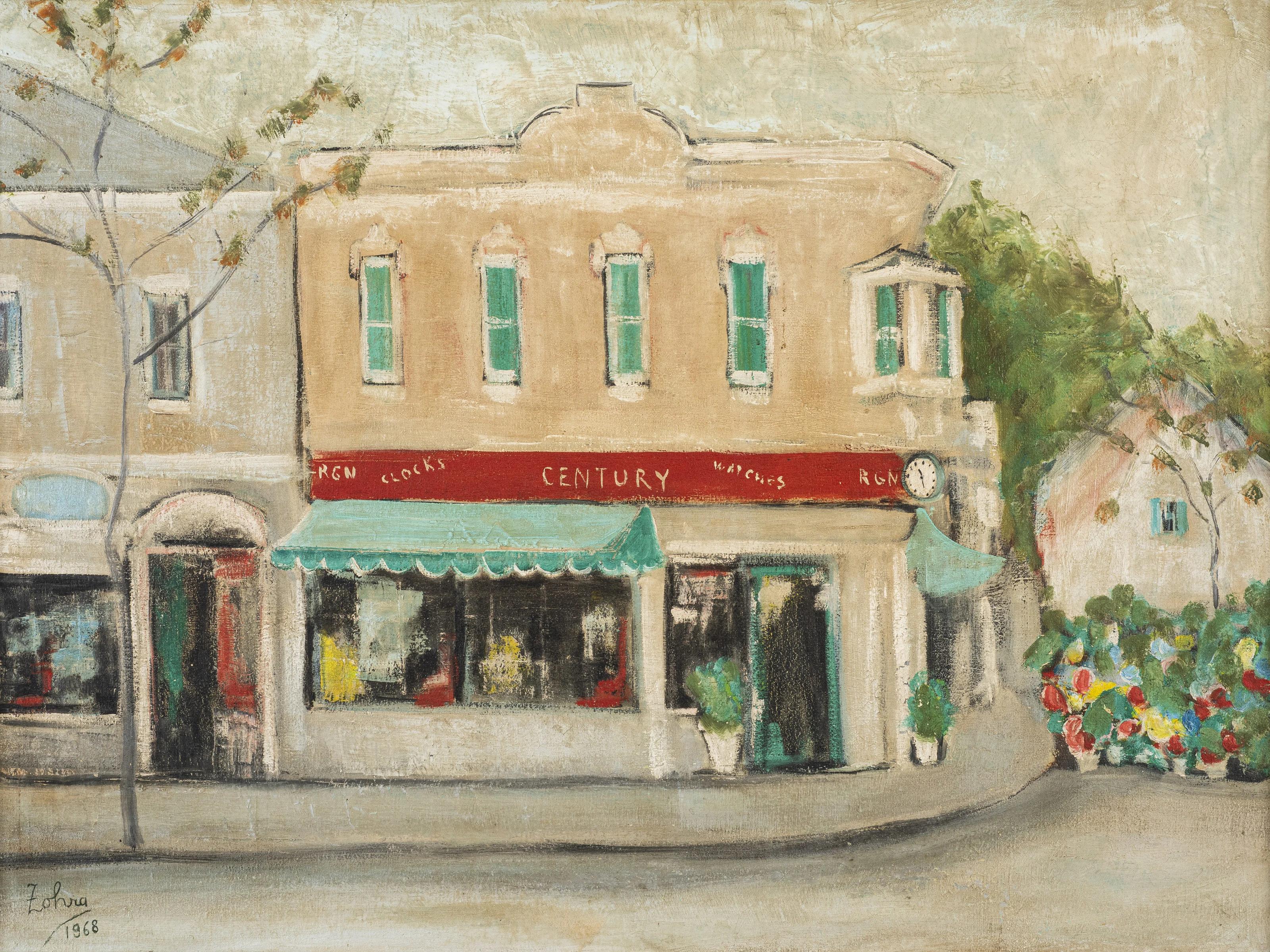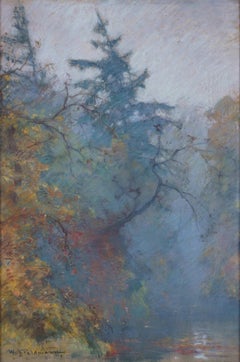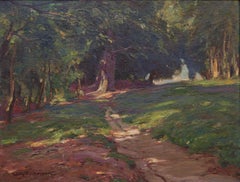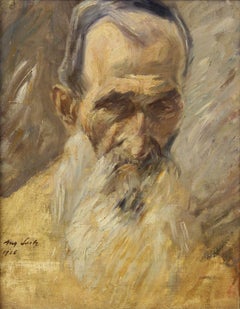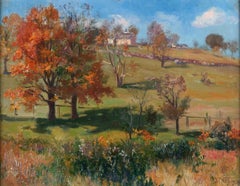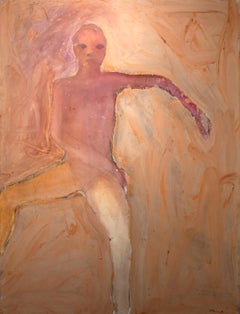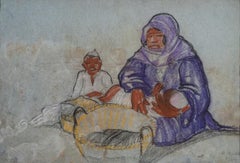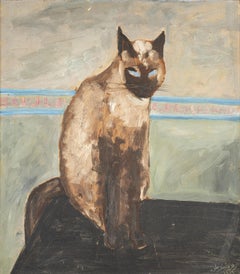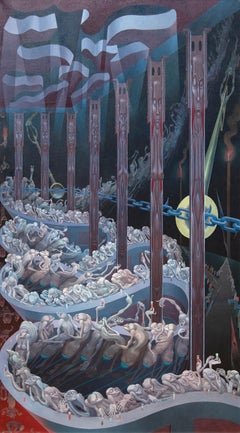Items Similar to White Mask on Violet Ground - Mythic mask mountain -
Want more images or videos?
Request additional images or videos from the seller
1 of 11
Herrmann SchütteWhite Mask on Violet Ground - Mythic mask mountain -1962
1962
About the Item
Hermann Schütte (1893 Osnabrück - 1973 Hamburg), White Mask on Violet Ground. Enameled copper plate on wooden base, 37 x 29.5 cm, monogrammed and dated "S[chütte] [19]62" in the lower right corner of the fire, inscribed on the reverse (by another hand?) with "Hermann Schütte", titled as "Mask" and dated "1962".
- upper corner slightly creased, otherwise very good condition
- Mythic mask mountain -
About the artwork
In his late work, Hermann Schütte discovered the enamel technique for his artistic work, thus establishing a genre between painting and sculpture, which at the same time has something architectural about it through the wall-like structure of the background. But because the 'stone offset' runs vertically, the 'wall' is a 'surreal wall'. It is this fantastic dimension that feeds the mysterious effect of the work. The Prussian blue background is related to the unfathomable depth of Yves Klein's blue. The pronounced craquelé created by the firing also gives the blue an organic vibrancy. It seems to have contracted by itself. The resulting cracks reveal the reddish-brown copper underneath, giving the blue a deep ground on which it seems to 'float'.
Above the moving, vibrant blue ground, which nevertheless appears solid because of the stone-like structure, is a mountain-like formation with two eye slits and a nose, revealing itself - as the title suggests - to be a mask. However, this is not a mask that can be put on, it has a life of its own and is thus in the tradition of medieval leaf masks, the most prominent example of which can be seen on the pedestal of the Bamberg Rider (around 1230).
Shaped like a mountain and equipped with its own nose, the mask also displays its own organic liveliness through the gray surfaces, which are also vertically aligned and seem to have grown, which is further intensified by the sand-like ghostly structure of the white surfaces. The fact that the eye openings remain black and thus blind, yet appear deeper in color than the blue, adds to the mysterious dimension of this enigmatic creature.
The white "mountain mask" and the blue ground create a pattern-ground relationship that is ornamentally enlivened by the craquelure. The vibrant blue ground, reminiscent of Babylonian tiles, and the anthropomorphic mountain mask unfold an archaic, fairy-tale dimension that lends depth to the mysterious and at the same time spreads as a surface sheen.
With the yellow monogramand the year in complementary contrast to the blue, the artist inscribes himself in this mystery.
About the artist
Hermann Schütte grew up in the era of the avant-garde and, like so many artists, volunteered for World War I, only to return home a convinced pacifist after the horrors he had witnessed. Inspired by literary expressionism, he wrote the book "Mensch! God! Ich!". Its cover was illustrated by the spiritus rector of the Worpswede artists' colony, Heinrich Vogeler. After becoming friends with Kurt Schwitters, Schütte created sculptures and installations in the spirit of the Dada movement initiated by Schwitters. During the Nazi era, Schütte withdrew into inner emigration, only to return to intense artistic activity after the Second World War.
Since 1948, Schütte has participated in numerous exhibitions, including those at the Hamburger Kunsthalle, in Oldenburg, Bremen, Worpswede, Witten, Bad Soden, Düsseldorf, and Osnabrück. In 1967, his hometown of Osnabrück dedicated a large monographic exhibition to him, in which 120 of his works provided an overview of his oeuvre.
Selected Bibliography
Rabe, Hanns-Gerd (Einleitung): Hermann Schütte. Ölgemälde, Emailbilder, Federzeichnungen. Katalog zur Ausstellung vom 29. Oktober bis 3. Dezember 1967, Städtisches Museum Osnabrück, Osnabrück 1967.
GERMAN VERSION
Hermann Schütte (1893 Osnabrück - 1973 Hamburg), Weiße Maske auf violettem Grund. Emaillierte Kupferplatten auf Holzgrund, 37 x 29,5 cm, rechts unten im Brand monogrammiert und datiert „S[chütte] [19]62“, rückseitig (von fremder Hand?) mit „Hermann Schütte“ bezeichnet, als „Maske“ betitelt und mit „1962“ datiert.
- obere Ecke leicht bestoßen, sonst in sehr gutem Zustand
Exposé als PDF
- Mystischer Maskenberg -
zum Kunstwerk
In seinem Spätwerk hat Hermann Schütte die Emailtechnik für sein künstlerisches Schaffen entdeckt und damit eine Gattung zwischen Gemälde und Skulptur etabliert, die durch die mauerverbundartige Struktur des Hintergrundes hier zugleich etwas Architektonisches hat. Indem der ‚Steinversatz‘ aber vertikal verläuft, ist die ‚Mauer‘ eine ‚surreale Mauer‘. Aus eben dieser phantastischen Dimension speist sich die geheimnisvolle Wirkung des Kunstwerks. Der in Preußisch Blau gehaltene Hintergrund weist eine Verwandtschaft mit der unergründlichen Tiefe des Blaus von Yves Klein auf. Durch das beim Brand entstandene ausgeprägte Craquelé gewinnt das Blau zudem eine organische Lebendigkeit. Es hat sich scheinbar von sich aus zusammengezogen. Die dabei entstandenen Risse geben das darunterliegende braunrote Kupfer frei, wodurch dem Blau ein Tiefengrund verliehen wird, auf dem es zu ‚schwimmen‘ scheint.
Über dem bewegt lebendigen blauen Grund, der vermittels der steinversatzartigen Struktur dennoch solide erscheint, ist eine bergartige Formation zu sehen, die zwei Augenschlitze und eine Nase aufweist und sich damit – dem Titel entsprechend – als Maske zu erkennen gibt. Diese Maske ist aber keine Maske, die zum Aufsetzen bereitliegen würde, vielmehr führt auch sie ein Eigenleben und steht damit in der Tradition mittelalterlicher Blattmasken, deren prominentesten Beispiel am Postament des Bamberger Reiter (um 1230) zu sehen ist.
Wie ein Berg ausgebildet und mit einer eigenen Nase versehen, weist auch die Maske durch die ebenfalls vertikal ausgerichteten und wie gewachsen wirkenden grauen Flächen eine eigene organische Lebendigkeit auf, die von der sandartig gespengelten Struktur der weißen Flächen noch intensiviert wird. Dass die Augenöffnungen schwarz bleiben und damit blind sind, farblich aber dennoch tiefer als das Blau wirken, befördert die geheimnisvolle Dimension dieses rätselhaften Wesens.
Die weiße ‚Bergmaske‘ und der blaue Grund schließen sich zu einem Muster-Grund-Verhältnis zusammen, das vom Craquelé ornamental belebt wird. Der an babylonische Fliesen gemahnende, lebendige blaue Grund und die anthropomorphe Bergmaske entfalten eine archaisch-märchenhafte Dimension, die dem Geheimnisvollen ihre Tiefe verleiht und sich zugleich als Oberflächenglanz verbreitet.
Mit dem gelben zum Blau in Komplementärkontrast stehenden Monogramm und der Jahreszahl schreibt sich der Künstler selbst in dieses Geheimnis ein.
zum Künstler
Hermann Schütte wuchs in die Zeit der Avantgarden hinein und meldete sich – wie so viele Künstler – freiwillig zum ersten Weltkrieg, um nach den durchlebten Schrecken als überzeugter Pazifist heimzukehren. Vom literarischen Expressionismus erfasst, schrieb er 1919 das Buch "Mensch! Gott! Ich!", dessen Umschlag der Spiritus rector der Künstlerkolonie Worpswede, Heinrich Vogeler, illustrierte. Nachdem Schütte mit Kurt Schwitters in freundschaftlichen Kontakt getreten war, schuf er Plastiken und Installationen im Geiste der von Schwitters initiierten Dada-Bewegung. Während der Zeit des Nationalsozialismus zog sich Schütte in die innere Emigration zurück, um nach dem zweiten Weltkrieg wieder intensiv künstlerisch tätig zu werden.
Seit 1948 nahm Schütte an einer Vielzahl von Ausstellungen teil, u.a. in der Hamburger Kunsthalle, in Oldenburg, Bremen, Worpswede, Witten, Bad Soden, Düsseldorf und Osnabrück. 1967 widmete ihm seine Vaterstadt Osnabrück eine große monographische Ausstellung, auf der 120 seiner Werke eine Übersicht über sein Schaffen vermittelten.
Auswahlbibliographie
Rabe, Hanns-Gerd (Einleitung): Hermann Schütte. Ölgemälde, Emailbilder, Federzeichnungen. Katalog zur Ausstellung vom 29. Oktober bis 3. Dezember 1967, Städtisches Museum Osnabrück, Osnabrück 1967.

About the Seller
5.0
Gold Seller
Premium sellers maintaining a 4.3+ rating and 24-hour response times
Established in 2014
1stDibs seller since 2023
16 sales on 1stDibs
Typical response time: 6 hours
- ShippingRetrieving quote...Shipping from: Berlin, Germany
- Return Policy
Authenticity Guarantee
In the unlikely event there’s an issue with an item’s authenticity, contact us within 1 year for a full refund. DetailsMoney-Back Guarantee
If your item is not as described, is damaged in transit, or does not arrive, contact us within 7 days for a full refund. Details24-Hour Cancellation
You have a 24-hour grace period in which to reconsider your purchase, with no questions asked.Vetted Professional Sellers
Our world-class sellers must adhere to strict standards for service and quality, maintaining the integrity of our listings.Price-Match Guarantee
If you find that a seller listed the same item for a lower price elsewhere, we’ll match it.Trusted Global Delivery
Our best-in-class carrier network provides specialized shipping options worldwide, including custom delivery.More From This Seller
View AllImpressionist Autumn Landscape with Lake / - Diffuse Concretion -
Located in Berlin, DE
Wilhelm Feldmann (1859 Lüneburg - 1932 Lübeck), Impressionist autumn landscape with lake, around 1905. Pastel on cardboard, 46 cm x 31 cm (inside dimension), 52 cm x 37 cm (frame), s...
Category
Early 1900s Impressionist Landscape Paintings
Materials
Gouache
Forest landscape bathed in sunlight / - The Monumentality of the Forest -
Located in Berlin, DE
Wilhelm Feldmann (1859 Lüneburg - 1932 Lübeck), Sunny forest landscape, c. 1900. Oil on canvas, marouflaged on wood, 37 cm x 48 cm (inside dimensions), 42.5 cm x 53.5 cm (frame), sig...
Category
Early 1900s Impressionist Landscape Paintings
Materials
Oil
Half-length portrait of an elderly bearded man - Melancholy of a prophet -
Located in Berlin, DE
Friedrich August Seitz (1902 Staffort - 1944 Belgrade). Half-length portrait of an elderly man with a beard. Oil on canvas, 42 x 34 cm (visible seize), 58 x 50 cm (frame), signed and...
Category
1920s Expressionist Figurative Paintings
Materials
Oil
Autumn Landscape in Sunlight - Indian Summer -
Located in Berlin, DE
Frederick Vezin (1859 Torresdale Philadelphia - 1933 Düsseldorf), Autumn Landscape in the Sunlight, oil on canvas, mounted on cardboard, 32 x 41 cm (inside measurement), 44 x 51 cm (frame), signed and dates lower right "F. Vezin. [19]05".
- Cardboard slightly curved, small inconspicuous retouch at the centre of the upper edge of the picture.
About the artwork
Although the painting appears to be a sketch, Frederick Vezin considered it to be a finished work of art, as evidenced by his signature on the lower right. And it is precisely this sketchy quality that leads to an understanding of the painting, which was certainly created in the landscape itself: the natural phenomena were to be depicted artistically at the moment of their observation. This is not done by meticulously sketching nature, but - and here Vezin follows the teaching of French Impressionism - by illustrating nature in its visual fullness. The artist's eye is, as it were, immersed in the visuality of nature, which is made visible by his hand. The painting is therefore not a reflection of the landscape, but its artistic intensification.
This intensification also includes the fact that the foreground of the painting - corresponding to the field of vision - eludes a detail-oriented close-up view. Instead, the spatula-like application of paint, the vertical structure of which corresponds to the structure of the floral growth, has the effect of making nature tangible in its colourful substance.
At the same time, the foreground, which remains indeterminate in its concrete objectivity, creates an atmospheric space that connects with the actual protagonist of the picture, the group of trees, which flares up in shades of red and brown. Here, too, the leaves are more speckled than clearly outlined. It is precisely this 'sketchiness' that opens up a visual experience that makes the landscape accessible in its visual fullness, thus revealing its essence.
In addition to this abundance, the landscape is presented as a structure of order in that the composition of the picture makes the composition of the landscape visible. For example, the group of trees forms a distinct dark green shadow, which is repeated in the shadows cast by the trees behind it. A patterned diagonal axis is created in the picture, which is composed in this way by the landscape itself.
Strictly speaking, this is a cultivated landscape: a fence at the bottom and a low stone wall at the top, running from left to right, are two elements that also have a strong compositional effect. And on the top of the hill, a stone house is embedded in the landscape as the brightest surface in the picture. Nature and culture here form a harmonious synthesis, giving the painting an Arcadian touch.
In order to give the landscape as much space as possible, the horizon line is raised, but the design of the sky is also crucial. The clouds, combined with the shapes of the trees, create a bright blue sky. To the European eye, such a sky is reminiscent of a summer landscape. Accordingly, within the seasonal cycle, the blue sky is reserved for summer, and French Impressionism is also primarily an ode to summer. In Vezin's painting, however, the brilliant blue sky stands above an autumnal landscape, some of the trees even defoliated. It can therefore be assumed that the painting was made not in Europe but in the United States, and that it illustrates the proverbial Indian summer, making Frederick Vezin a pioneer of American landscape painting.
About the artist
Frederick Vezin was the son of a French immigrant to the United States and a German-born mother. This predestined him to promote artistic exchange between the old and new worlds. Having spent part of his schooling in Germany, in 1876, at the age of 20, he enrolled at the Düsseldorf Academy of Art, where he studied with Peter Janssen the Elder, Eduard von Gebhardt and Wilhelm Sohn, among others. He graduated in 1883, settled in Munich and returned to Düsseldorf in 1895, where he lived until his death in 1933.
A native of the United States, he travelled to the country frequently and became a popular portrait and society painter. His artistic talent, however, was most evident in his landscape paintings. Trained in French Impressionism, he developed a virtuoso use of colour and a free brushwork that remained tied to the landscape motif, opening up the landscape itself in a new way. Frederick Vezin turned his attention primarily to the landscape of his homeland, becoming a pioneer of modern American landscape...
Category
Early 1900s Impressionist Landscape Paintings
Materials
Cardboard, Oil
$2,019 Sale Price
20% Off
Eccentric discharges of a blue-red core / - Energetic traces -
Located in Berlin, DE
Klaus Oldenburg (*1942 Berlin), Eccentric discharges of a blue-red core, around 1975. paint and cast resin on chipboard, 39 x 59 cm (inside dimension),...
Category
1970s Abstract Abstract Paintings
Materials
Resin
$596 Sale Price
20% Off
Eccentric discharges of a turquoise-yellow core / - Energetic traces -
Located in Berlin, DE
Klaus Oldenburg (*1942 Berlin), Eccentric discharges of a turquoise-yellow core, around 1975. paint and cast resin on chipboard, 39 x 59 cm (inside dim...
Category
1970s Abstract Paintings
Materials
Resin
$596 Sale Price
20% Off
You May Also Like
Untitled
By Nathan Oliveira
Located in Palm Desert, CA
A painting by Nathan Oliveira. "Untitled" is a Bay Area Figurative Painting, oil on canvas in a brown and tan palette by American artist Nathan Oliveira. The artwork is signed in the lower right, "Oliveira 64".
A Californian whose work is of preeminent importance during the post war period, Oliveira is most often associated with Park, Diebenkorn and the other artists with whom he sketched early in his career. Yet it was not an oversight when Oakland Museum director Paul Mills chose not to include Oliveira in the 1957 exhibition “Contemporary Bay Area Figurative Painting.” All came to figuration by initiating a sophisticated dialogue with abstraction, yet it is Oliveira, the often characterized ambivalent loner among Bay Area artists whose work is most often compared to Alberto Giacometti, Francis Bacon, or Willem de Kooning with whom he shared walls and space at The Images of Man exhibition held in New York at the Museum of Modern Art in 1959.
During the early years, Oliveira’s lone figures often suggested an existential angst similar to that of Giacometti, but there was also a weightlessness and a transcendent aura that envelopes these figures; they appear as elemental, universal and eternal projections of selfless consciousness better understood within the bodiless realm of metaphysics. These qualities would remain in his work throughout his long career, yet he would find other themes to explore — the natural world where the essential nature of birds and animals exist in equal profundity with their human counterparts, the transient world of evanescent perception when memory must reconstruct momentary experience, and later, the ‘site’ paintings and monoprints that suggest the abandoned remnants of a long-lost civilization or tribe uncovered at an archeological dig.
Through and through, flesh to bones, and bones to dust Nathan Oliveira has left us with a legacy of art that will surely remain untarnished by time or changing trends. His work exists within a realm rarely achieved by artists striving in a similar mode of expression. Unclouded by ego or wayward sentiment, it is also in the warmth and humble nature...
Category
Late 20th Century Post-War Figurative Paintings
Materials
Canvas, Oil
$125,000
"Nurturing" Pastel on Paper Painting 13" x 19" inch (1964) by Ragheb Ayad
By Ragheb Ayad
Located in Culver City, CA
"Nurturing" Pastel on Paper Painting 13" x 19" inch (1964) by Ragheb Ayad
signed & dated
Ragheb Ayad was born in Cairo on the 10th of March 1892 and insc...
Category
20th Century Post-War Figurative Paintings
Materials
Paper, Pastel
"Le Chat I" Oil Painting 20" x 19" inch (1959) by Zohra Efflatoun
By Zohra Efflatoun
Located in Culver City, CA
"Le Chat I" Oil Painting 20" x 19" inch (1959) by Zohra Efflatoun
signed & dated
Zohra Efflatoun came from an artistic family. Her half-sister Inji w...
Category
20th Century Post-War Figurative Paintings
Materials
Oil, Cardboard
Bacchanal
By Irving Norman
Located in Palm Desert, CA
A painting by Irving Norman. "Bacchanal" is a macabre social surrealism painting, oil on canvas in a dark palette of reds, blues, and blacks by artist Irving Norman. The artwork is u...
Category
Mid-20th Century Post-War Figurative Paintings
Materials
Canvas, Oil
$125,000
American Street Scene
By Irving Norman
Located in Palm Desert, CA
A painting by Irving Norman. "American Street Scene" is a macabre social surrealism city scape, oil on canvas in a bold palette of reds, blues, and yellows by artist Irving Norman. T...
Category
Mid-20th Century Post-War Figurative Paintings
Materials
Canvas, Oil
"Paris Street Corner" Oil Painting 20" x 28" inch (1968) by Zohra Efflatoun
By Zohra Efflatoun
Located in Culver City, CA
"Paris Street Corner" Oil Painting 20" x 28" inch (1968) by Zohra Efflatoun
signed & dated
Zohra Efflatoun came from an artistic family. Her half-sis...
Category
20th Century Post-War Figurative Paintings
Materials
Canvas, Oil
Recently Viewed
View AllMore Ways To Browse
German Painting Mountain
Surreal War
Dior Vertical
Wooden Masks
War Mask
Yves Klein Blue
Blue White Pedestals
Enamel On Copper Painting
Enamel Painting On Copper
Klein Home
Post War Wall Sculpture
Tile Purple
Purple Vintage Hat
Vintage Black And White Tile
Vintage Enamel Tile
Mountain Surreal Painting
Vintage Wooden Mask
Wooden Vertical Sculpture
